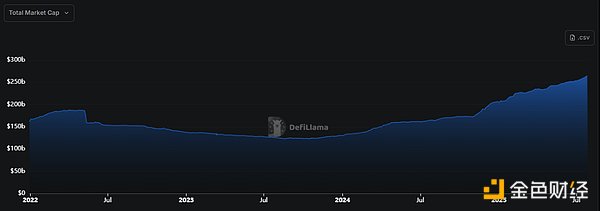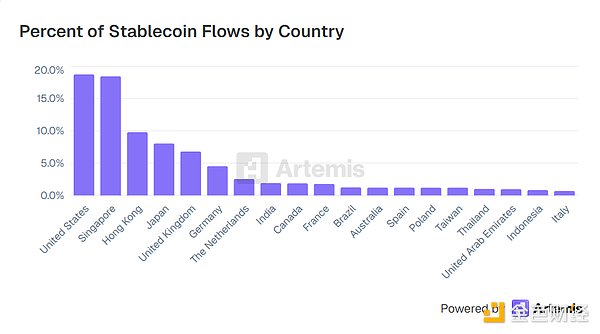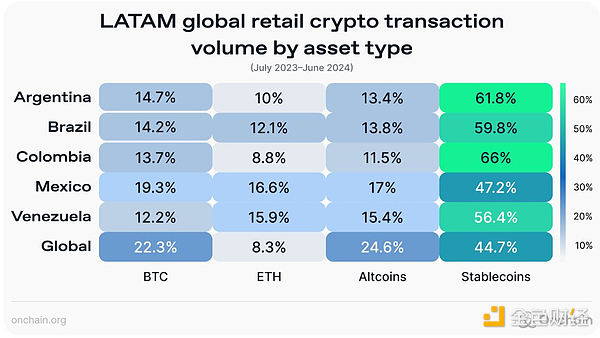Source: Castle Labs, Compiled by Shaw Jinse Finance Over the past 12 months, stablecoins have moved from the fringes of cryptocurrency to broader financial significance. Simply by the numbers, stablecoin supply has more than doubled, and usage has surpassed that of traditional networks and institutional players, demonstrating growing demand for these assets. But the deeper change lies in a structural shift. Once simply a place for cryptocurrency traders to park their profits, stablecoins are now becoming a transaction layer in emerging economies, a settlement tool in fintech stacks, and a strategic monetary extension of US monetary policy. This report compares mid-2024 with mid-2025, tracking the growth of stablecoin adoption, regional shifts, and the current status of stablecoins as a product and concept.
Global Trend: From Liquidity Tools to Functional Infrastructure
Market Cap and Usage Growth

The market capitalization of stablecoins rebounded from approximately $160 billion in mid-2024 to over $260 billion in July 2025. This represented an increase of over 60% in one year and brought the total amount of stablecoins in circulation beyond its 2022 peak. Stablecoin liquidity also set a new record. On-chain transaction volume provides a clearer picture. In 2024, stablecoin settlements exceeded $27.6 trillion, exceeding the combined volume of Visa and Mastercard. Monthly transaction volume doubled year-over-year, from $1.9 trillion in February 2024 to $4.1 trillion in February 2025. In December 2024, stablecoin transaction volume peaked at $5.1 trillion. This data demonstrates that capital flows are no longer confined to the cryptocurrency sector. In some ecosystems, stablecoin transaction value exceeds half of total transaction value. Between mid-2024 and mid-2025, the number of active wallets jumped from approximately 20 million to approximately 40 million. The total number of addresses holding stablecoin balances has exceeded 120 million. This growth is not only reflected in quantity but also in diversification. A growing number of small businesses, freelancers, and remittance users are using stablecoins to transfer funds, often without interacting with the broader cryptocurrency market. Institutional Integration: In 2024, stablecoins have become a financial tool, not only used by cryptocurrency companies but also increasingly adopted by fintech firms, asset managers, and some enterprises. The rationale is simple: stablecoins are fast, programmable, dollar-denominated assets that can be transferred across platforms 24/7 without relying on the traditional banking system. For companies operating internationally or across multiple time zones, this means improved liquidity management, faster internal transfers, and reduced settlement delays. With interest rates remaining high for much of 2024, holding idle funds in stablecoins like USDC has become more attractive. Many of these stablecoins are backed by short-term government bonds. While users don't directly receive the returns on these assets, the reserve structure provides confidence that the underlying assets are high-quality and yield interest. Stablecoins have become a viable option for companies seeking a reliably backed digital alternative to the US dollar. This year, stablecoins have become even more widely used within fintech architectures. Visa expanded USDC settlement to Ethereum and Solana. Stripe and PayPal introduced stablecoins to consumer payment platforms. Even banks have begun testing local currency stablecoins, such as Standard Chartered's Hong Kong dollar stablecoin, to explore faster cross-border settlements. Tether's $13 billion profit in 2024, more than double BlackRock's, underscores the financial importance of the reserve model. This demonstrates that stablecoin issuers are not only supporting infrastructure development but also operating extremely profitable businesses. This profitability translates into sustainability, fostering user trust and accelerating adoption within the broader financial sector. Fiat-backed stablecoins, i.e. those fully backed by cash or short-term government bonds, have grown from approximately 85% of the market share in 2024 to over 90% today. The supply of USDT has increased from approximately $83 billion to approximately $150 billion. USDC has rebounded from its 2023 low to approximately $59 billion, regaining favor with institutional users. Stablecoins such as PayPal's PYUSD and Paxos' USDP have also seen modest adoption, but the real gains have been concentrated among top users. Users now generally expect stablecoins to have fully backed and transparent reserves, although this comes with the trade-off of centralized custody and regulatory risks. Crypto-collateralized and algorithmic stablecoins. Crypto-collateralized stablecoins, represented by DAI, remained stable, with a slight increase in absolute value (approximately $5 billion) but a decline in market share. Protocols like Aave (GHO) and Curve (crvUSD) saw hundreds of millions of dollars in circulation, but the reality is that crypto-collateralized stablecoins have neither achieved a breakthrough nor collapsed. Meanwhile, algorithmic stablecoins have essentially vanished. After the Terra debacle, trust in non-overcollateralized designs faded, and many projects, including Frax Finance, moved to fully collateralized models in 2023. Since then, no new algorithmic stablecoin model has gained any meaningful momentum. Today, fiat-backed stablecoins dominate in terms of both adoption and trust. Crypto-backed stablecoins, while smaller in scale, are fully functional. Once considered an inevitable trend, algorithmic stablecoins have largely faded from the conversation. The Rise of Yield-Based Stablecoins: An emerging category to watch in 2025 is yield-based stablecoins, assets designed not only to preserve value but also to increase it. Unlike traditional fiat-backed or overcollateralized models, these tokens explicitly incorporate returns from real-world or on-chain strategies into their structure. Two notable examples are Ethena's USDe and Resolv Labs' RUSD. Ethena Labs' USDe employs a neutral strategy, pairing staked Ethereum collateral with a perpetual short position to maintain its peg to the US dollar and generate synthetic yield. This yield is distributed to holders via a separate token, sUSDe. This model garnered early attention for its composability, transparent yield mechanism, and ability to generate yield without relying on a centralized reserve. As of mid-2025, USDe's supply remains small relative to major stablecoins, but it is one of the few experiments to achieve meaningful adoption and remain stable under pressure following the Terra debacle. In contrast, Resolv Labs links returns to real-world yield-generating assets, creating a structure more akin to a tokenized treasury bond, but wrapped in a stablecoin. RUSD strives to maintain its peg to the dollar while providing a stable yield through partnerships with off-chain credit and structured products. This is a more institutional approach, with adoption primarily concentrated on decentralized finance (DeFi) protocols and early-stage lending platforms. These models are still experimental, with limited adoption compared to existing fiat-backed models. But they represent a clear trend: users want not only stability but also passive income. The challenge lies in simultaneously maintaining transparency, peg stability, and regulatory clarity. If any of these factors falter, confidence can quickly fade. Yield-bearing stablecoins have already established themselves. They haven't replaced USDT or USDC, but they expand the design space and offer a more capital-efficient alternative for users willing to accept different risk profiles. Whether they can scale without inheriting the vulnerabilities of previous algorithmic stablecoins remains to be seen. But for now, they are receiving more attention than anything that has emerged since the UST collapse.
Regional Behavioral Shifts

Emerging Markets: Latin America, Africa
Motivation: Stability and Access to Dollars
In countries facing inflation and currency volatility, stablecoins are emerging as digital alternatives to the dollar. Argentina, Venezuela, and Nigeria are examples of this. In 2024, when these countries' local currencies depreciate, demand for USDT will surge. By 2025, holding digital dollars will become the norm for both individuals and businesses. In Africa, where foreign exchange shortages affect over 70% of countries, stablecoins now connect local economies to global capital. Exchanges in Nigeria often quote prices in USDT. When banks are unable to provide dollars, businesses use stablecoins to pay overseas suppliers. Remittances and Payments: Remittance channels are significantly shifting toward stablecoins. In Latin America, cross-border cryptocurrency transfers grew by over 40% in 2024. By 2025, applications like Binance P2P and Airtm will become the primary remittance tools for the entire community. The average cost of sending $200 via stablecoins in Sub-Saharan Africa is approximately 60% lower than using traditional remittance channels. This isn't a trivial improvement, but rather a transformational one, demonstrating product-market fit. Preferred Platforms and Tokens: Tron remains the leading public blockchain for stablecoin activity in emerging markets due to its low fees. Most informal and peer-to-peer markets use USDT on Tron. Bitcoin Token Sale (BSC) and Solana have also gained market share, but Tron remains the default choice in many regions. USDC is making progress through fintech integration, particularly in contexts where regulatory scrutiny or institutional relationships are a concern. However, USDT remains far ahead in terms of grassroots adoption.

Regulatory Attitude
Governments remain cautious. Brazil has introduced digital asset regulations and is exploring the launch of a central bank digital currency. South Africa is developing dedicated guidelines for stablecoins. Most other emerging market countries are still waiting and watching. While recognizing their utility, they are also concerned about dollarization and capital flight. Currently, the use of stablecoins is largely tolerated, especially when there are no alternatives. Southeast Asia and South Asia: In Southeast Asia, the use of stablecoins is driven less by concerns about inflation than by convenience. In countries like the Philippines and Vietnam, remittances are a key driver. People working abroad are sending USDT or USDC back home through apps like Coins.ph or BloomX. In India, traders and freelancers use stablecoins to transfer funds between platforms or mitigate exchange rate losses on the rupee. Vietnam continues to see strong retail cryptocurrency adoption. Meanwhile, Singapore has taken a more institutional approach, issuing stablecoin licenses and encouraging formal issuance. East Asia and Financial Centers Hong Kong and Singapore are positioning themselves as regulated stablecoin hubs. The Monetary Authority of Singapore (MAS) has established clear guidelines (reserve backing, redemption terms) by the end of 2024. USDC and regional stablecoin issuers are seeking licenses there by 2025. Japan established a legal framework in 2023 allowing banks to issue stablecoins. Several yen-pegged stablecoins are currently live, but they remain relatively unpopular. In South Korea, due to strict regulations, stablecoin use remains primarily focused on trading. Developed Markets: Integration, Not Replacement Usage Patterns In the United States and Europe, stablecoins are rarely used for everyday purchases. Instead, they are embedded in fintech systems, corporate treasuries, and cross-border settlements. Businesses use stablecoins to transfer funds between subsidiaries. Freelancers accept USDC for international work. Following the 2023 banking crisis, cryptocurrency companies now rely on stablecoins rather than ACH or SWIFT for fiat transactions. Franklin Templeton's on-chain money market fund is settled in USDC. Mastercard and MoneyGram have begun offering stablecoin-based services. These integrations suggest a complementary expansion of stablecoins in the fintech sector, rather than a complete replacement. Regulatory Momentum: The EU's MiCA framework came into effect in mid-2024. By mid-2025, implementation was fully underway: non-euro stablecoins faced daily transaction caps, and issuers were applying for licenses. The UK also passed legislation designating stablecoins as digital settlement assets. In the US, the GENIUS Act was recently passed, but its impact has yet to be felt. Previously, regulators had indirectly influenced this sector through enforcement actions (such as the decline of BUSD) and market behavior (the concentration of USDC/USDT), but this situation is changing. Stablecoins now account for over 1% of the M2 money supply, a fact that Federal Reserve officials have begun to publicly acknowledge. Key Comparison: Mid-2024 vs. Mid-2025 Conclusion: From Parallel Assets to Embedded Tiers Between July 2024 and July 2025, stablecoins crossed a line, transitioning from their origins as cryptocurrency-native tools to becoming independent, parallel financial systems. In emerging markets, they became a stopgap measure to address weak monetary systems and expensive banking services. In developed markets, however, stablecoins are being integrated into regulated and compliant workflows. Market structure reflects this evolution. Fiat-backed stablecoins dominate, holding over 90% of the market. Algorithmic and unbacked stablecoins, once central to the idea of "decentralization," have largely vanished. Stablecoin adoption is now driven more by practicality and trust than ideology. The regulatory landscape hasn't fully caught up, but it's gaining momentum. Institutions, banks, fintechs, and payment giants are all closing in. At this stage, the question for stablecoins is no longer whether they will be regulated, but how they will be governed and integrated by existing organizations, how much value they will hold, and where that value will flow. Stablecoins are unlikely to completely replace fiat currencies, but they are already filling gaps where they struggle during after-hours trading, for cross-border transactions, or in economies with weak infrastructure. What happens next will depend less on hype and more on the continued utility of stablecoins, clear rules, and the ability to scale their benefits without compromising stability and transparency. But the past year has clearly shown momentum for stablecoins. They have found a role, and it's a much larger one than most anticipated.
 Aaron
Aaron








